International Business Strategies - Doc
VerifiedAdded on 2021/05/31
|9
|2207
|60
AI Summary
Contribute Materials
Your contribution can guide someone’s learning journey. Share your
documents today.
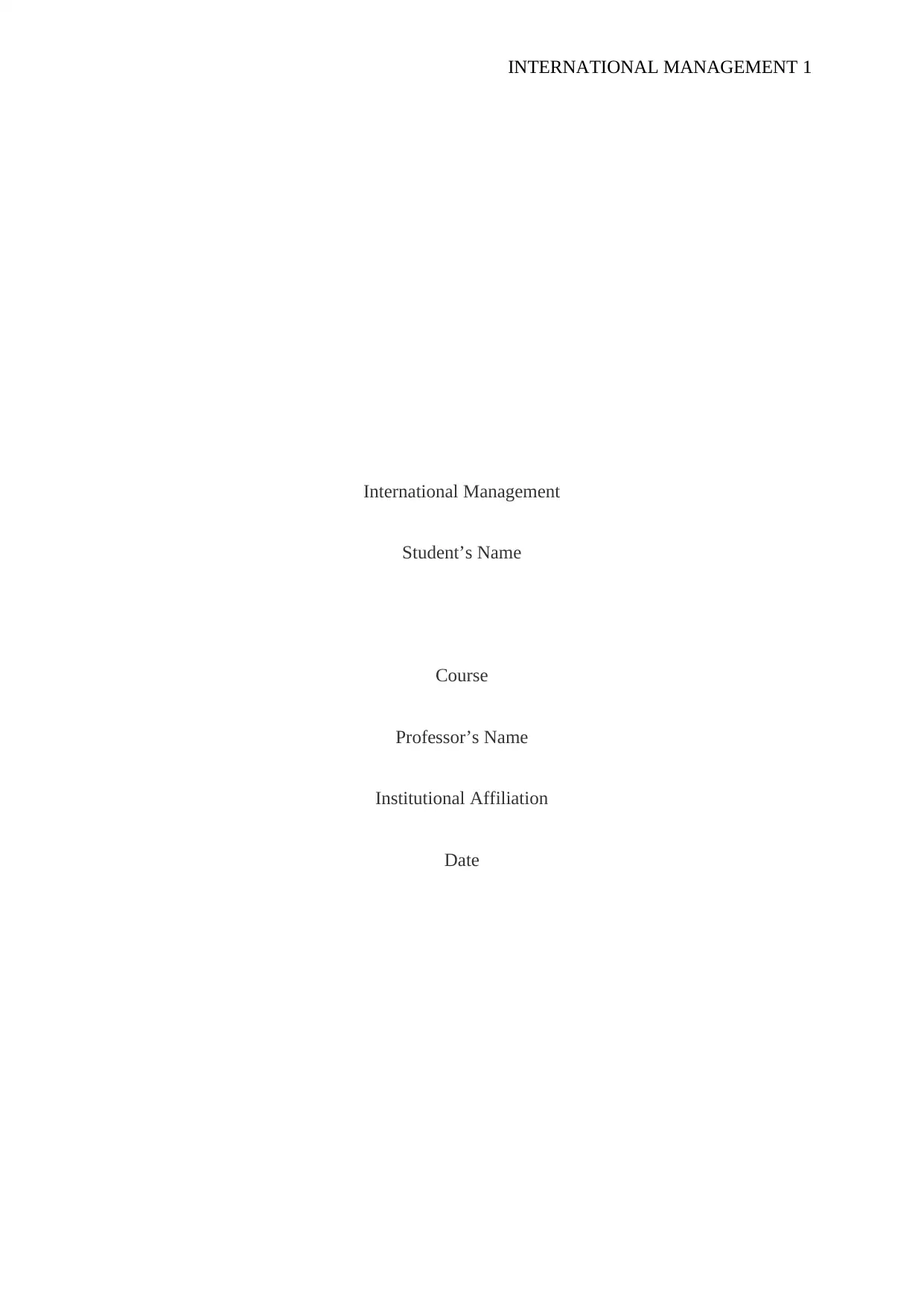
INTERNATIONAL MANAGEMENT 1
International Management
Student’s Name
Course
Professor’s Name
Institutional Affiliation
Date
International Management
Student’s Name
Course
Professor’s Name
Institutional Affiliation
Date
Secure Best Marks with AI Grader
Need help grading? Try our AI Grader for instant feedback on your assignments.
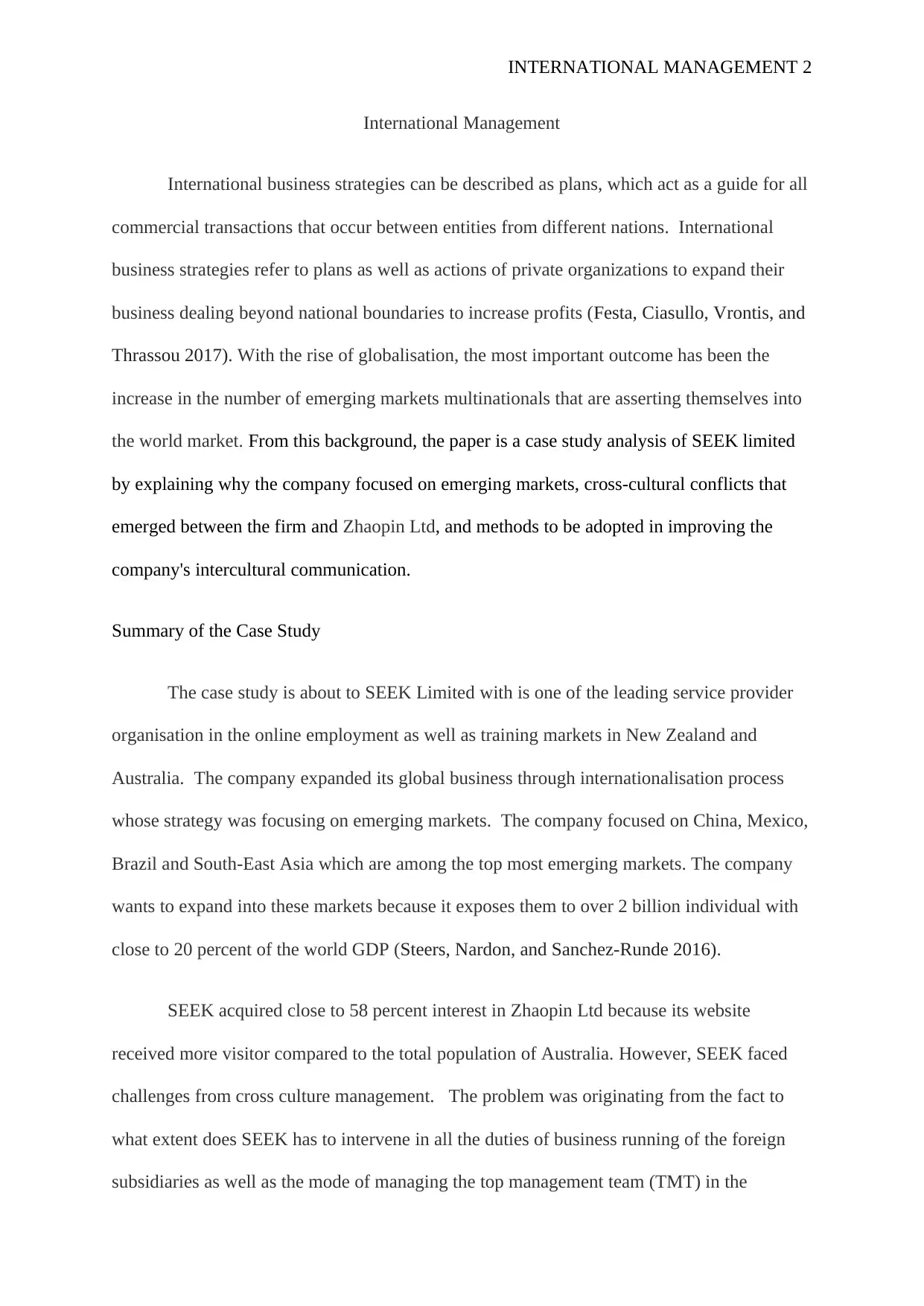
INTERNATIONAL MANAGEMENT 2
International Management
International business strategies can be described as plans, which act as a guide for all
commercial transactions that occur between entities from different nations. International
business strategies refer to plans as well as actions of private organizations to expand their
business dealing beyond national boundaries to increase profits (Festa, Ciasullo, Vrontis, and
Thrassou 2017). With the rise of globalisation, the most important outcome has been the
increase in the number of emerging markets multinationals that are asserting themselves into
the world market. From this background, the paper is a case study analysis of SEEK limited
by explaining why the company focused on emerging markets, cross-cultural conflicts that
emerged between the firm and Zhaopin Ltd, and methods to be adopted in improving the
company's intercultural communication.
Summary of the Case Study
The case study is about to SEEK Limited with is one of the leading service provider
organisation in the online employment as well as training markets in New Zealand and
Australia. The company expanded its global business through internationalisation process
whose strategy was focusing on emerging markets. The company focused on China, Mexico,
Brazil and South-East Asia which are among the top most emerging markets. The company
wants to expand into these markets because it exposes them to over 2 billion individual with
close to 20 percent of the world GDP (Steers, Nardon, and Sanchez-Runde 2016).
SEEK acquired close to 58 percent interest in Zhaopin Ltd because its website
received more visitor compared to the total population of Australia. However, SEEK faced
challenges from cross culture management. The problem was originating from the fact to
what extent does SEEK has to intervene in all the duties of business running of the foreign
subsidiaries as well as the mode of managing the top management team (TMT) in the
International Management
International business strategies can be described as plans, which act as a guide for all
commercial transactions that occur between entities from different nations. International
business strategies refer to plans as well as actions of private organizations to expand their
business dealing beyond national boundaries to increase profits (Festa, Ciasullo, Vrontis, and
Thrassou 2017). With the rise of globalisation, the most important outcome has been the
increase in the number of emerging markets multinationals that are asserting themselves into
the world market. From this background, the paper is a case study analysis of SEEK limited
by explaining why the company focused on emerging markets, cross-cultural conflicts that
emerged between the firm and Zhaopin Ltd, and methods to be adopted in improving the
company's intercultural communication.
Summary of the Case Study
The case study is about to SEEK Limited with is one of the leading service provider
organisation in the online employment as well as training markets in New Zealand and
Australia. The company expanded its global business through internationalisation process
whose strategy was focusing on emerging markets. The company focused on China, Mexico,
Brazil and South-East Asia which are among the top most emerging markets. The company
wants to expand into these markets because it exposes them to over 2 billion individual with
close to 20 percent of the world GDP (Steers, Nardon, and Sanchez-Runde 2016).
SEEK acquired close to 58 percent interest in Zhaopin Ltd because its website
received more visitor compared to the total population of Australia. However, SEEK faced
challenges from cross culture management. The problem was originating from the fact to
what extent does SEEK has to intervene in all the duties of business running of the foreign
subsidiaries as well as the mode of managing the top management team (TMT) in the
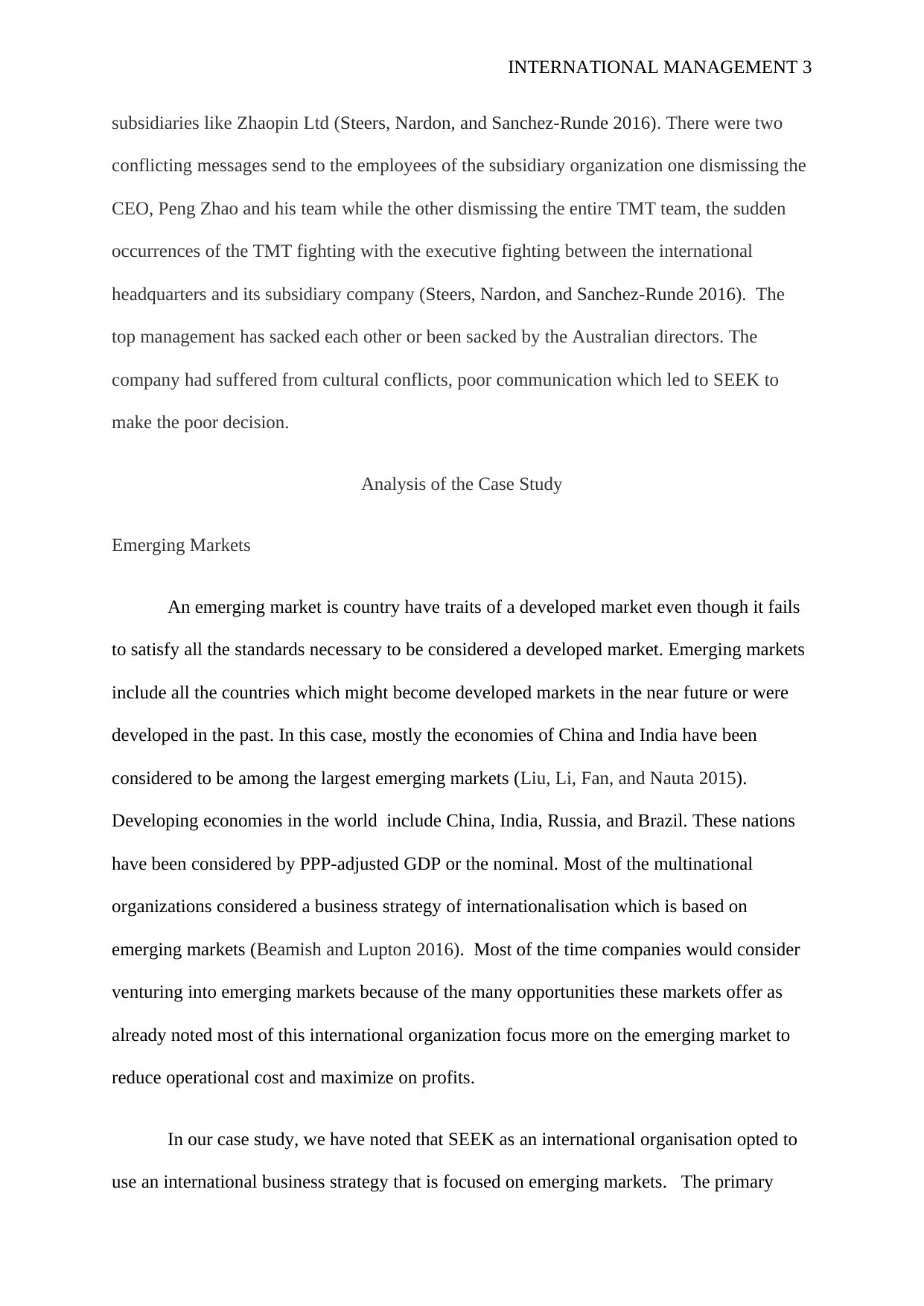
INTERNATIONAL MANAGEMENT 3
subsidiaries like Zhaopin Ltd (Steers, Nardon, and Sanchez-Runde 2016). There were two
conflicting messages send to the employees of the subsidiary organization one dismissing the
CEO, Peng Zhao and his team while the other dismissing the entire TMT team, the sudden
occurrences of the TMT fighting with the executive fighting between the international
headquarters and its subsidiary company (Steers, Nardon, and Sanchez-Runde 2016). The
top management has sacked each other or been sacked by the Australian directors. The
company had suffered from cultural conflicts, poor communication which led to SEEK to
make the poor decision.
Analysis of the Case Study
Emerging Markets
An emerging market is country have traits of a developed market even though it fails
to satisfy all the standards necessary to be considered a developed market. Emerging markets
include all the countries which might become developed markets in the near future or were
developed in the past. In this case, mostly the economies of China and India have been
considered to be among the largest emerging markets (Liu, Li, Fan, and Nauta 2015).
Developing economies in the world include China, India, Russia, and Brazil. These nations
have been considered by PPP-adjusted GDP or the nominal. Most of the multinational
organizations considered a business strategy of internationalisation which is based on
emerging markets (Beamish and Lupton 2016). Most of the time companies would consider
venturing into emerging markets because of the many opportunities these markets offer as
already noted most of this international organization focus more on the emerging market to
reduce operational cost and maximize on profits.
In our case study, we have noted that SEEK as an international organisation opted to
use an international business strategy that is focused on emerging markets. The primary
subsidiaries like Zhaopin Ltd (Steers, Nardon, and Sanchez-Runde 2016). There were two
conflicting messages send to the employees of the subsidiary organization one dismissing the
CEO, Peng Zhao and his team while the other dismissing the entire TMT team, the sudden
occurrences of the TMT fighting with the executive fighting between the international
headquarters and its subsidiary company (Steers, Nardon, and Sanchez-Runde 2016). The
top management has sacked each other or been sacked by the Australian directors. The
company had suffered from cultural conflicts, poor communication which led to SEEK to
make the poor decision.
Analysis of the Case Study
Emerging Markets
An emerging market is country have traits of a developed market even though it fails
to satisfy all the standards necessary to be considered a developed market. Emerging markets
include all the countries which might become developed markets in the near future or were
developed in the past. In this case, mostly the economies of China and India have been
considered to be among the largest emerging markets (Liu, Li, Fan, and Nauta 2015).
Developing economies in the world include China, India, Russia, and Brazil. These nations
have been considered by PPP-adjusted GDP or the nominal. Most of the multinational
organizations considered a business strategy of internationalisation which is based on
emerging markets (Beamish and Lupton 2016). Most of the time companies would consider
venturing into emerging markets because of the many opportunities these markets offer as
already noted most of this international organization focus more on the emerging market to
reduce operational cost and maximize on profits.
In our case study, we have noted that SEEK as an international organisation opted to
use an international business strategy that is focused on emerging markets. The primary
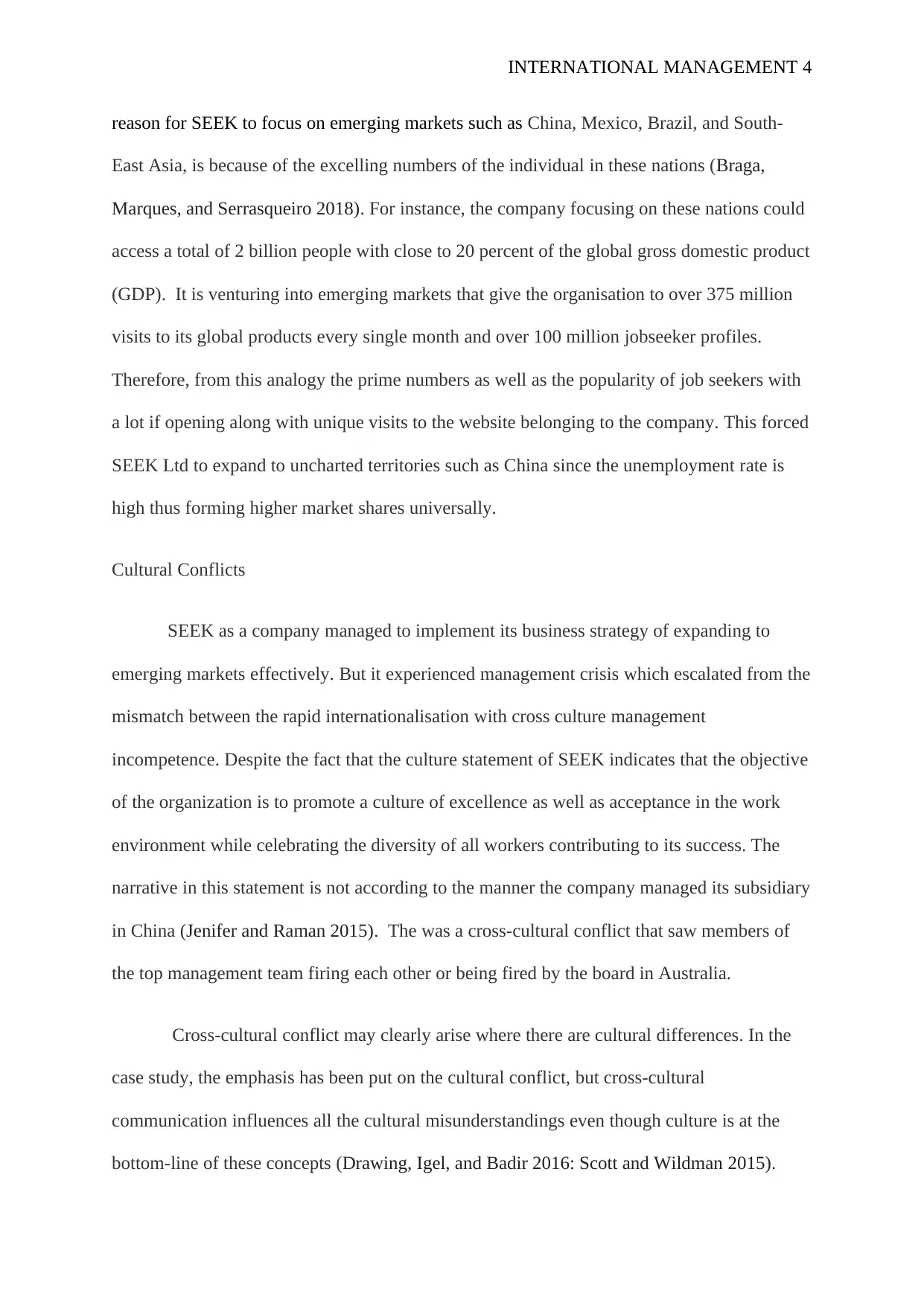
INTERNATIONAL MANAGEMENT 4
reason for SEEK to focus on emerging markets such as China, Mexico, Brazil, and South-
East Asia, is because of the excelling numbers of the individual in these nations (Braga,
Marques, and Serrasqueiro 2018). For instance, the company focusing on these nations could
access a total of 2 billion people with close to 20 percent of the global gross domestic product
(GDP). It is venturing into emerging markets that give the organisation to over 375 million
visits to its global products every single month and over 100 million jobseeker profiles.
Therefore, from this analogy the prime numbers as well as the popularity of job seekers with
a lot if opening along with unique visits to the website belonging to the company. This forced
SEEK Ltd to expand to uncharted territories such as China since the unemployment rate is
high thus forming higher market shares universally.
Cultural Conflicts
SEEK as a company managed to implement its business strategy of expanding to
emerging markets effectively. But it experienced management crisis which escalated from the
mismatch between the rapid internationalisation with cross culture management
incompetence. Despite the fact that the culture statement of SEEK indicates that the objective
of the organization is to promote a culture of excellence as well as acceptance in the work
environment while celebrating the diversity of all workers contributing to its success. The
narrative in this statement is not according to the manner the company managed its subsidiary
in China (Jenifer and Raman 2015). The was a cross-cultural conflict that saw members of
the top management team firing each other or being fired by the board in Australia.
Cross-cultural conflict may clearly arise where there are cultural differences. In the
case study, the emphasis has been put on the cultural conflict, but cross-cultural
communication influences all the cultural misunderstandings even though culture is at the
bottom-line of these concepts (Drawing, Igel, and Badir 2016: Scott and Wildman 2015).
reason for SEEK to focus on emerging markets such as China, Mexico, Brazil, and South-
East Asia, is because of the excelling numbers of the individual in these nations (Braga,
Marques, and Serrasqueiro 2018). For instance, the company focusing on these nations could
access a total of 2 billion people with close to 20 percent of the global gross domestic product
(GDP). It is venturing into emerging markets that give the organisation to over 375 million
visits to its global products every single month and over 100 million jobseeker profiles.
Therefore, from this analogy the prime numbers as well as the popularity of job seekers with
a lot if opening along with unique visits to the website belonging to the company. This forced
SEEK Ltd to expand to uncharted territories such as China since the unemployment rate is
high thus forming higher market shares universally.
Cultural Conflicts
SEEK as a company managed to implement its business strategy of expanding to
emerging markets effectively. But it experienced management crisis which escalated from the
mismatch between the rapid internationalisation with cross culture management
incompetence. Despite the fact that the culture statement of SEEK indicates that the objective
of the organization is to promote a culture of excellence as well as acceptance in the work
environment while celebrating the diversity of all workers contributing to its success. The
narrative in this statement is not according to the manner the company managed its subsidiary
in China (Jenifer and Raman 2015). The was a cross-cultural conflict that saw members of
the top management team firing each other or being fired by the board in Australia.
Cross-cultural conflict may clearly arise where there are cultural differences. In the
case study, the emphasis has been put on the cultural conflict, but cross-cultural
communication influences all the cultural misunderstandings even though culture is at the
bottom-line of these concepts (Drawing, Igel, and Badir 2016: Scott and Wildman 2015).
Secure Best Marks with AI Grader
Need help grading? Try our AI Grader for instant feedback on your assignments.
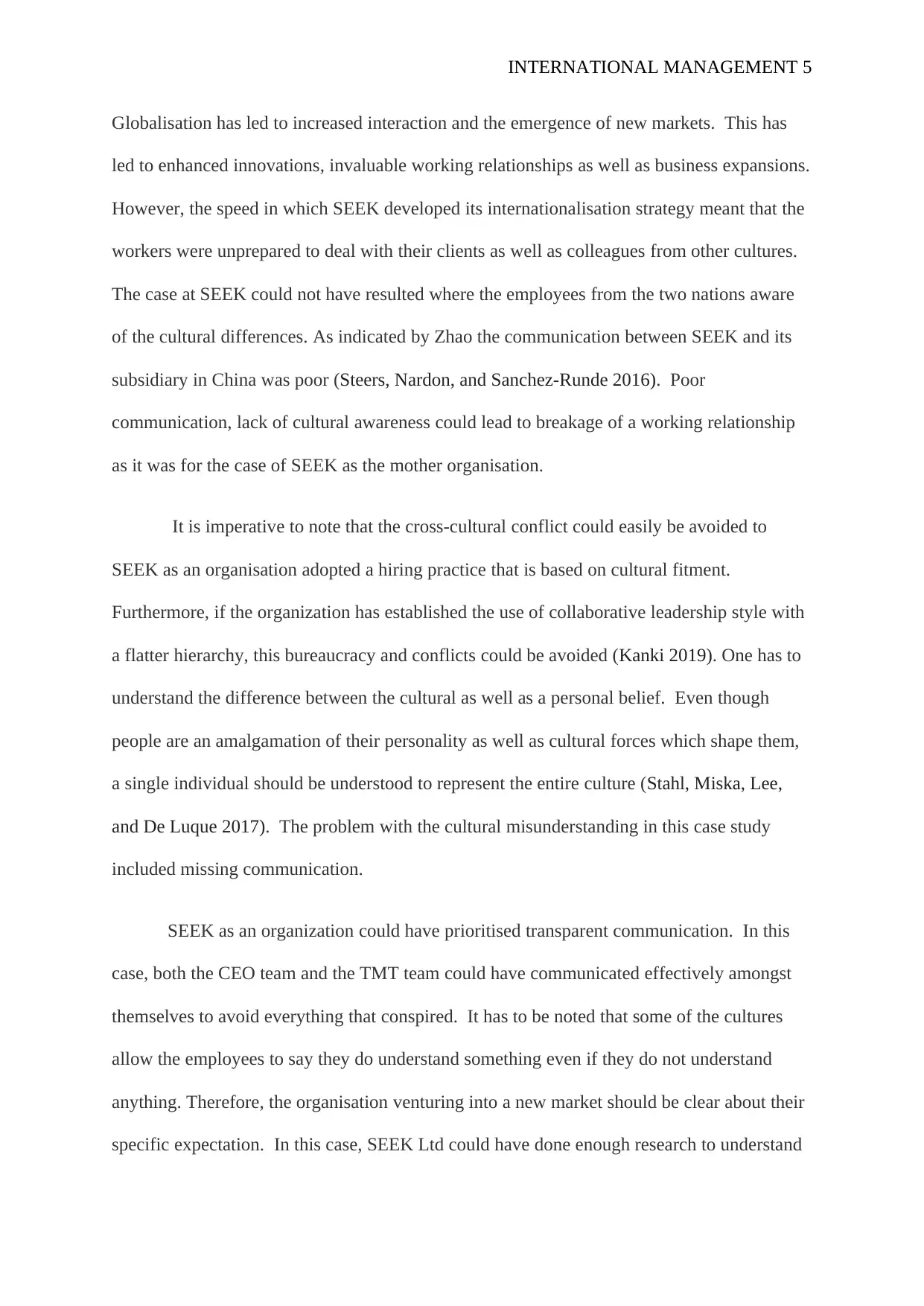
INTERNATIONAL MANAGEMENT 5
Globalisation has led to increased interaction and the emergence of new markets. This has
led to enhanced innovations, invaluable working relationships as well as business expansions.
However, the speed in which SEEK developed its internationalisation strategy meant that the
workers were unprepared to deal with their clients as well as colleagues from other cultures.
The case at SEEK could not have resulted where the employees from the two nations aware
of the cultural differences. As indicated by Zhao the communication between SEEK and its
subsidiary in China was poor (Steers, Nardon, and Sanchez-Runde 2016). Poor
communication, lack of cultural awareness could lead to breakage of a working relationship
as it was for the case of SEEK as the mother organisation.
It is imperative to note that the cross-cultural conflict could easily be avoided to
SEEK as an organisation adopted a hiring practice that is based on cultural fitment.
Furthermore, if the organization has established the use of collaborative leadership style with
a flatter hierarchy, this bureaucracy and conflicts could be avoided (Kanki 2019). One has to
understand the difference between the cultural as well as a personal belief. Even though
people are an amalgamation of their personality as well as cultural forces which shape them,
a single individual should be understood to represent the entire culture (Stahl, Miska, Lee,
and De Luque 2017). The problem with the cultural misunderstanding in this case study
included missing communication.
SEEK as an organization could have prioritised transparent communication. In this
case, both the CEO team and the TMT team could have communicated effectively amongst
themselves to avoid everything that conspired. It has to be noted that some of the cultures
allow the employees to say they do understand something even if they do not understand
anything. Therefore, the organisation venturing into a new market should be clear about their
specific expectation. In this case, SEEK Ltd could have done enough research to understand
Globalisation has led to increased interaction and the emergence of new markets. This has
led to enhanced innovations, invaluable working relationships as well as business expansions.
However, the speed in which SEEK developed its internationalisation strategy meant that the
workers were unprepared to deal with their clients as well as colleagues from other cultures.
The case at SEEK could not have resulted where the employees from the two nations aware
of the cultural differences. As indicated by Zhao the communication between SEEK and its
subsidiary in China was poor (Steers, Nardon, and Sanchez-Runde 2016). Poor
communication, lack of cultural awareness could lead to breakage of a working relationship
as it was for the case of SEEK as the mother organisation.
It is imperative to note that the cross-cultural conflict could easily be avoided to
SEEK as an organisation adopted a hiring practice that is based on cultural fitment.
Furthermore, if the organization has established the use of collaborative leadership style with
a flatter hierarchy, this bureaucracy and conflicts could be avoided (Kanki 2019). One has to
understand the difference between the cultural as well as a personal belief. Even though
people are an amalgamation of their personality as well as cultural forces which shape them,
a single individual should be understood to represent the entire culture (Stahl, Miska, Lee,
and De Luque 2017). The problem with the cultural misunderstanding in this case study
included missing communication.
SEEK as an organization could have prioritised transparent communication. In this
case, both the CEO team and the TMT team could have communicated effectively amongst
themselves to avoid everything that conspired. It has to be noted that some of the cultures
allow the employees to say they do understand something even if they do not understand
anything. Therefore, the organisation venturing into a new market should be clear about their
specific expectation. In this case, SEEK Ltd could have done enough research to understand
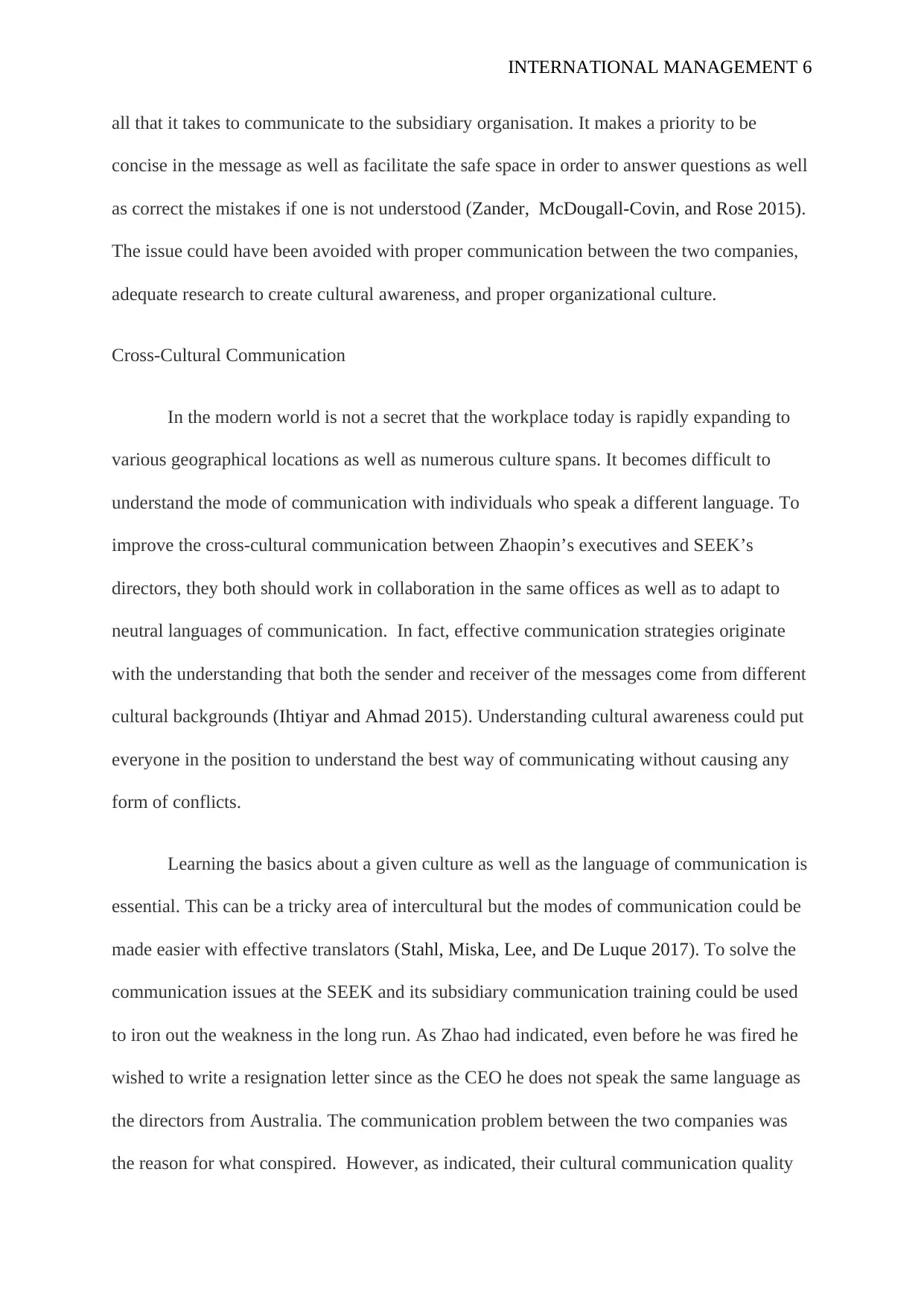
INTERNATIONAL MANAGEMENT 6
all that it takes to communicate to the subsidiary organisation. It makes a priority to be
concise in the message as well as facilitate the safe space in order to answer questions as well
as correct the mistakes if one is not understood (Zander, McDougall-Covin, and Rose 2015).
The issue could have been avoided with proper communication between the two companies,
adequate research to create cultural awareness, and proper organizational culture.
Cross-Cultural Communication
In the modern world is not a secret that the workplace today is rapidly expanding to
various geographical locations as well as numerous culture spans. It becomes difficult to
understand the mode of communication with individuals who speak a different language. To
improve the cross-cultural communication between Zhaopin’s executives and SEEK’s
directors, they both should work in collaboration in the same offices as well as to adapt to
neutral languages of communication. In fact, effective communication strategies originate
with the understanding that both the sender and receiver of the messages come from different
cultural backgrounds (Ihtiyar and Ahmad 2015). Understanding cultural awareness could put
everyone in the position to understand the best way of communicating without causing any
form of conflicts.
Learning the basics about a given culture as well as the language of communication is
essential. This can be a tricky area of intercultural but the modes of communication could be
made easier with effective translators (Stahl, Miska, Lee, and De Luque 2017). To solve the
communication issues at the SEEK and its subsidiary communication training could be used
to iron out the weakness in the long run. As Zhao had indicated, even before he was fired he
wished to write a resignation letter since as the CEO he does not speak the same language as
the directors from Australia. The communication problem between the two companies was
the reason for what conspired. However, as indicated, their cultural communication quality
all that it takes to communicate to the subsidiary organisation. It makes a priority to be
concise in the message as well as facilitate the safe space in order to answer questions as well
as correct the mistakes if one is not understood (Zander, McDougall-Covin, and Rose 2015).
The issue could have been avoided with proper communication between the two companies,
adequate research to create cultural awareness, and proper organizational culture.
Cross-Cultural Communication
In the modern world is not a secret that the workplace today is rapidly expanding to
various geographical locations as well as numerous culture spans. It becomes difficult to
understand the mode of communication with individuals who speak a different language. To
improve the cross-cultural communication between Zhaopin’s executives and SEEK’s
directors, they both should work in collaboration in the same offices as well as to adapt to
neutral languages of communication. In fact, effective communication strategies originate
with the understanding that both the sender and receiver of the messages come from different
cultural backgrounds (Ihtiyar and Ahmad 2015). Understanding cultural awareness could put
everyone in the position to understand the best way of communicating without causing any
form of conflicts.
Learning the basics about a given culture as well as the language of communication is
essential. This can be a tricky area of intercultural but the modes of communication could be
made easier with effective translators (Stahl, Miska, Lee, and De Luque 2017). To solve the
communication issues at the SEEK and its subsidiary communication training could be used
to iron out the weakness in the long run. As Zhao had indicated, even before he was fired he
wished to write a resignation letter since as the CEO he does not speak the same language as
the directors from Australia. The communication problem between the two companies was
the reason for what conspired. However, as indicated, their cultural communication quality
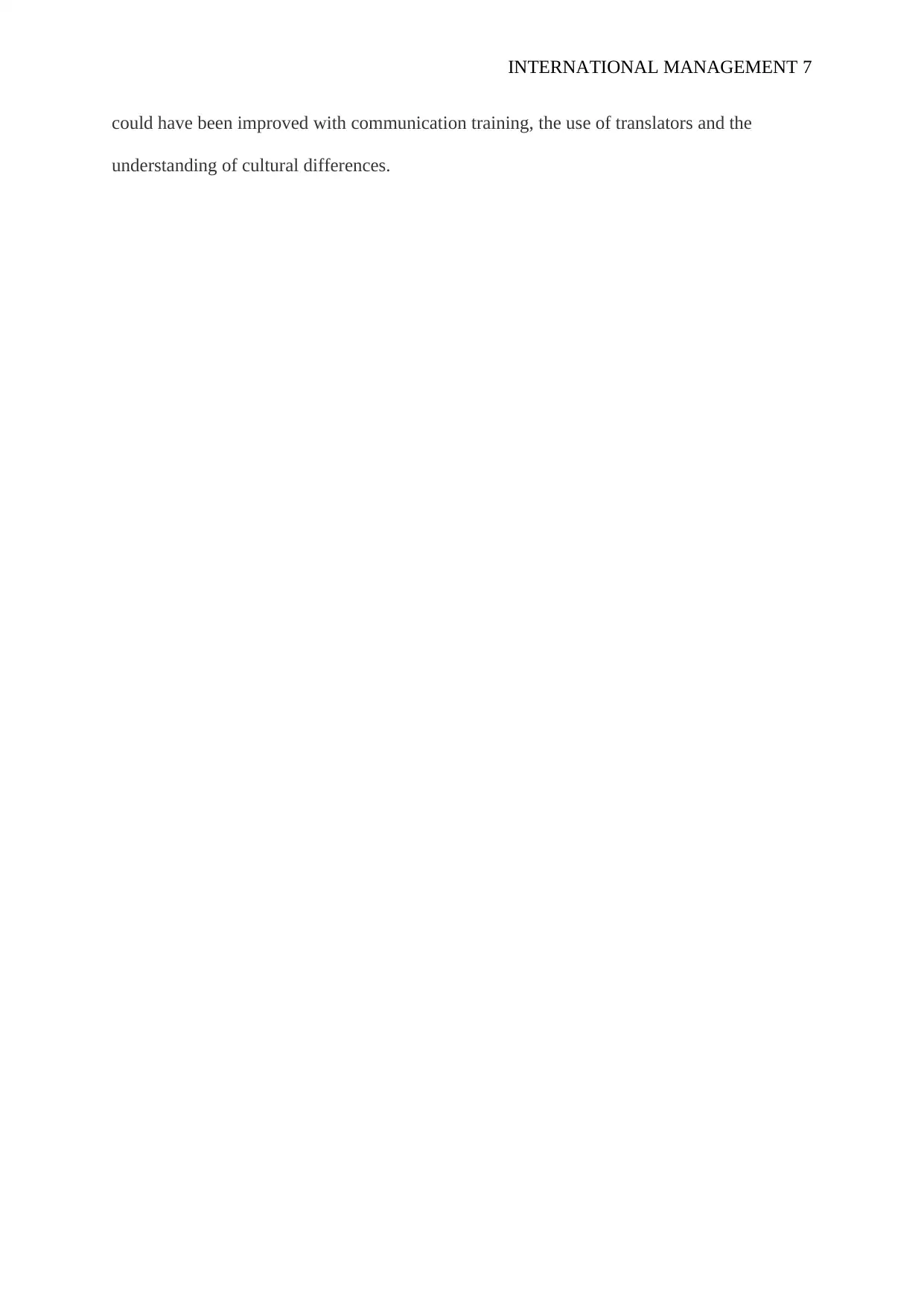
INTERNATIONAL MANAGEMENT 7
could have been improved with communication training, the use of translators and the
understanding of cultural differences.
could have been improved with communication training, the use of translators and the
understanding of cultural differences.
Paraphrase This Document
Need a fresh take? Get an instant paraphrase of this document with our AI Paraphraser
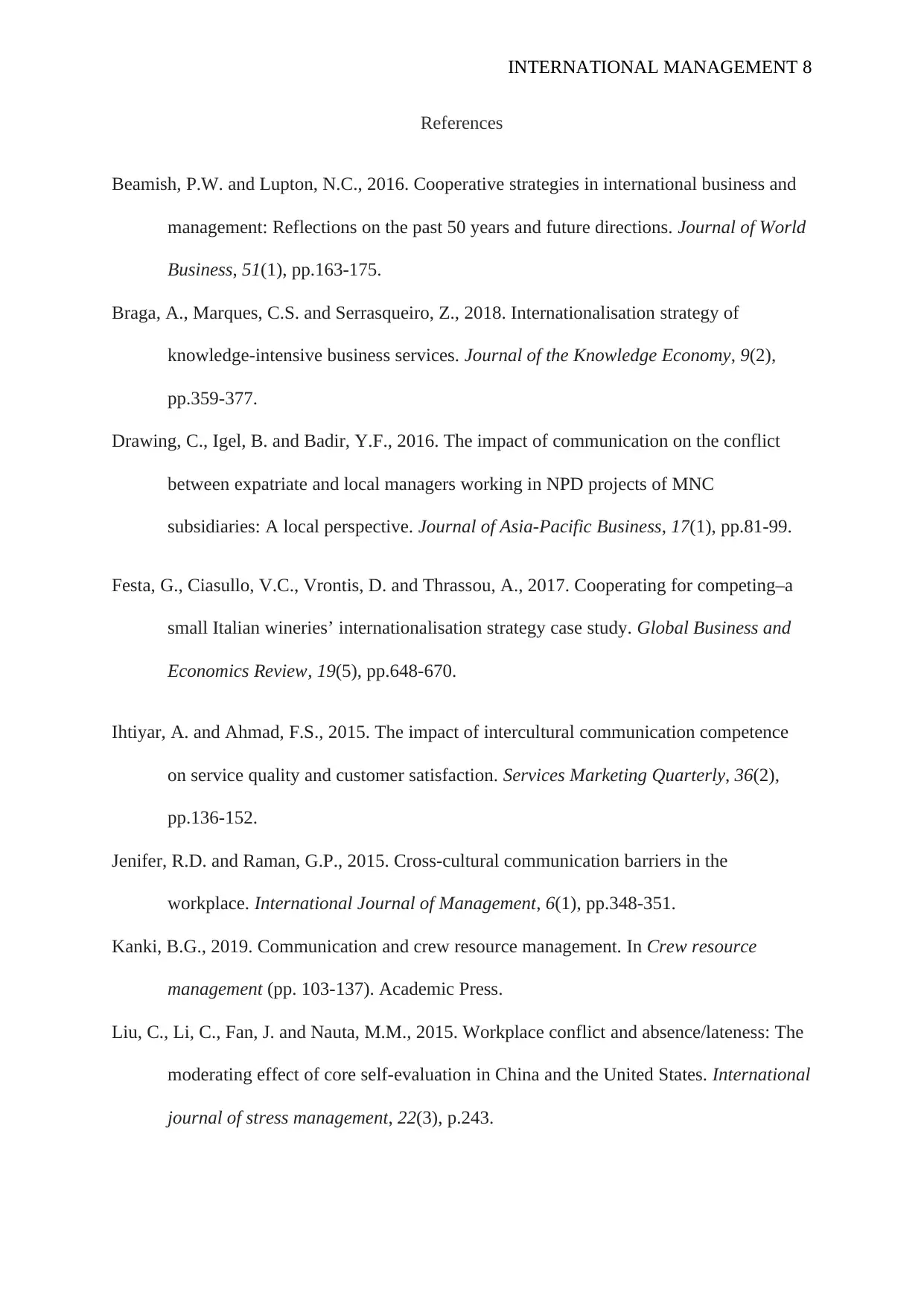
INTERNATIONAL MANAGEMENT 8
References
Beamish, P.W. and Lupton, N.C., 2016. Cooperative strategies in international business and
management: Reflections on the past 50 years and future directions. Journal of World
Business, 51(1), pp.163-175.
Braga, A., Marques, C.S. and Serrasqueiro, Z., 2018. Internationalisation strategy of
knowledge-intensive business services. Journal of the Knowledge Economy, 9(2),
pp.359-377.
Drawing, C., Igel, B. and Badir, Y.F., 2016. The impact of communication on the conflict
between expatriate and local managers working in NPD projects of MNC
subsidiaries: A local perspective. Journal of Asia-Pacific Business, 17(1), pp.81-99.
Festa, G., Ciasullo, V.C., Vrontis, D. and Thrassou, A., 2017. Cooperating for competing–a
small Italian wineries’ internationalisation strategy case study. Global Business and
Economics Review, 19(5), pp.648-670.
Ihtiyar, A. and Ahmad, F.S., 2015. The impact of intercultural communication competence
on service quality and customer satisfaction. Services Marketing Quarterly, 36(2),
pp.136-152.
Jenifer, R.D. and Raman, G.P., 2015. Cross-cultural communication barriers in the
workplace. International Journal of Management, 6(1), pp.348-351.
Kanki, B.G., 2019. Communication and crew resource management. In Crew resource
management (pp. 103-137). Academic Press.
Liu, C., Li, C., Fan, J. and Nauta, M.M., 2015. Workplace conflict and absence/lateness: The
moderating effect of core self-evaluation in China and the United States. International
journal of stress management, 22(3), p.243.
References
Beamish, P.W. and Lupton, N.C., 2016. Cooperative strategies in international business and
management: Reflections on the past 50 years and future directions. Journal of World
Business, 51(1), pp.163-175.
Braga, A., Marques, C.S. and Serrasqueiro, Z., 2018. Internationalisation strategy of
knowledge-intensive business services. Journal of the Knowledge Economy, 9(2),
pp.359-377.
Drawing, C., Igel, B. and Badir, Y.F., 2016. The impact of communication on the conflict
between expatriate and local managers working in NPD projects of MNC
subsidiaries: A local perspective. Journal of Asia-Pacific Business, 17(1), pp.81-99.
Festa, G., Ciasullo, V.C., Vrontis, D. and Thrassou, A., 2017. Cooperating for competing–a
small Italian wineries’ internationalisation strategy case study. Global Business and
Economics Review, 19(5), pp.648-670.
Ihtiyar, A. and Ahmad, F.S., 2015. The impact of intercultural communication competence
on service quality and customer satisfaction. Services Marketing Quarterly, 36(2),
pp.136-152.
Jenifer, R.D. and Raman, G.P., 2015. Cross-cultural communication barriers in the
workplace. International Journal of Management, 6(1), pp.348-351.
Kanki, B.G., 2019. Communication and crew resource management. In Crew resource
management (pp. 103-137). Academic Press.
Liu, C., Li, C., Fan, J. and Nauta, M.M., 2015. Workplace conflict and absence/lateness: The
moderating effect of core self-evaluation in China and the United States. International
journal of stress management, 22(3), p.243.
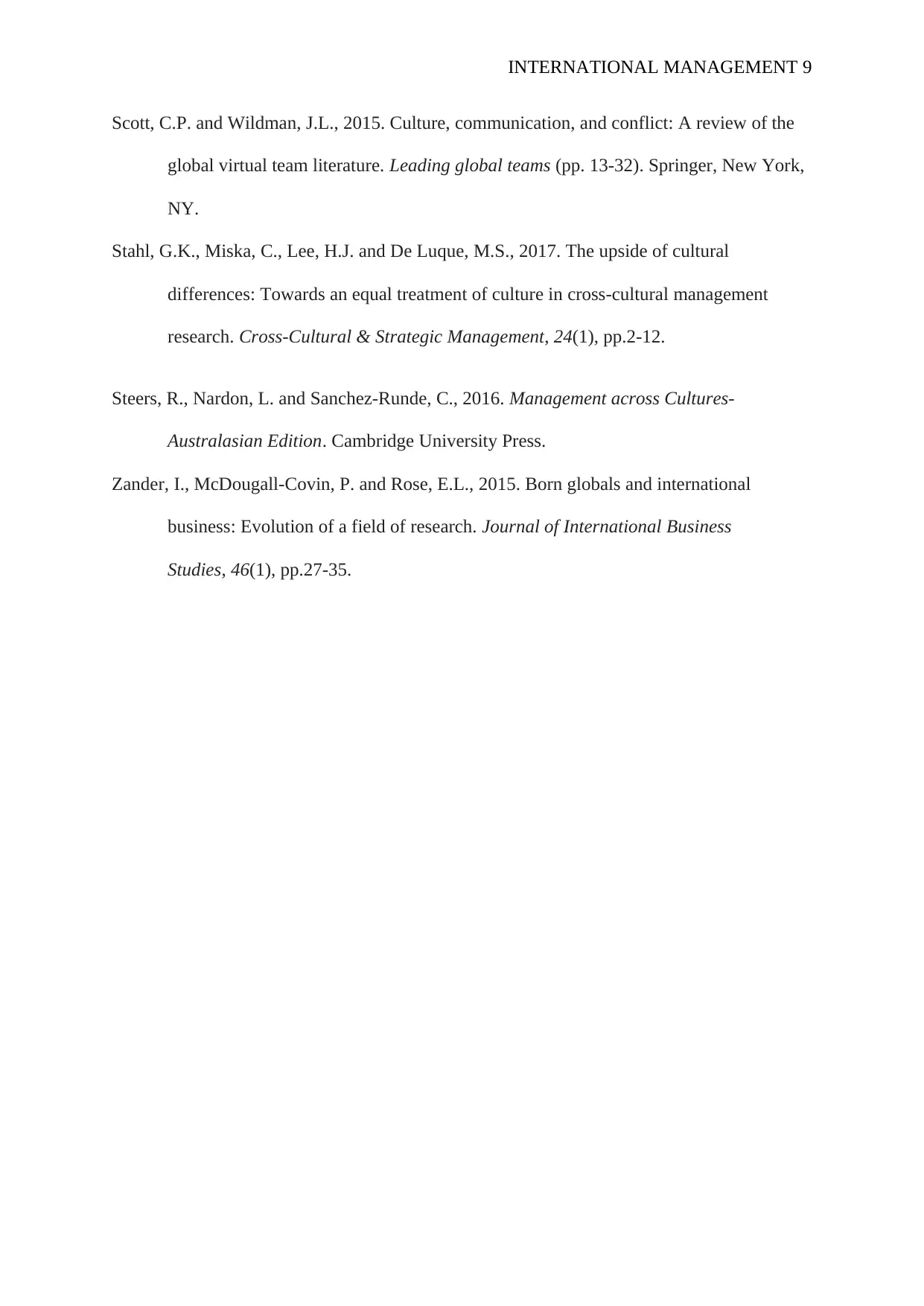
INTERNATIONAL MANAGEMENT 9
Scott, C.P. and Wildman, J.L., 2015. Culture, communication, and conflict: A review of the
global virtual team literature. Leading global teams (pp. 13-32). Springer, New York,
NY.
Stahl, G.K., Miska, C., Lee, H.J. and De Luque, M.S., 2017. The upside of cultural
differences: Towards an equal treatment of culture in cross-cultural management
research. Cross-Cultural & Strategic Management, 24(1), pp.2-12.
Steers, R., Nardon, L. and Sanchez-Runde, C., 2016. Management across Cultures-
Australasian Edition. Cambridge University Press.
Zander, I., McDougall-Covin, P. and Rose, E.L., 2015. Born globals and international
business: Evolution of a field of research. Journal of International Business
Studies, 46(1), pp.27-35.
Scott, C.P. and Wildman, J.L., 2015. Culture, communication, and conflict: A review of the
global virtual team literature. Leading global teams (pp. 13-32). Springer, New York,
NY.
Stahl, G.K., Miska, C., Lee, H.J. and De Luque, M.S., 2017. The upside of cultural
differences: Towards an equal treatment of culture in cross-cultural management
research. Cross-Cultural & Strategic Management, 24(1), pp.2-12.
Steers, R., Nardon, L. and Sanchez-Runde, C., 2016. Management across Cultures-
Australasian Edition. Cambridge University Press.
Zander, I., McDougall-Covin, P. and Rose, E.L., 2015. Born globals and international
business: Evolution of a field of research. Journal of International Business
Studies, 46(1), pp.27-35.
1 out of 9
Your All-in-One AI-Powered Toolkit for Academic Success.
+13062052269
info@desklib.com
Available 24*7 on WhatsApp / Email
![[object Object]](/_next/static/media/star-bottom.7253800d.svg)
Unlock your academic potential
© 2024 | Zucol Services PVT LTD | All rights reserved.
